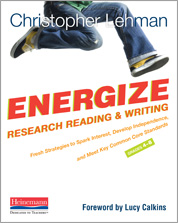Unorthodox View of Research
Energize Research Reading and Writing: Fresh Strategies to Spark Interest, Develop Independence, and Meet Key Common Core Standards
by Christopher Lehman
(Heinemann, 2012 – Learn more)
In Energize Research Reading and Writing, Christopher Lehman aims to challenge our learners (and our teachers) to think with higher levels of complexity and avoid being “spoon fed” through the research process. Lehman provides teachers working with students in grades 4 through 8 with tips and strategies for making research reading and writing applicable and motivating to our students. He also offers ideas on how to implement the Common Core Standards within classrooms, from a research perspective.

1. Research the Way It Was Meant to Be: A Re-Introduction
2. No More Handouts: Teach Students to Narrow Down Topics and Evaluate Sources Independently
3. Stop the Random Numbers and Recopied Paragraphs: Teach Students to Note-Take with Purpose, Not Indifference
4. Beyond “Put It into Your Own Words”: Teach Students to Write to Teach Ideas, Not Just Regurgitate Facts
5. Free From Graphic Organizers: Teach Students to Craft Organizing Structures with Their Readers in Mind
6. Without Agonizing Memorization: Teach Students to Cite Sources on Their Own
7. English or Content Areas, Long Studies or Short Projects: Turn Strategies into a Study That Matches the Needs in Your Classroom
Each chapter included student work samples, leveled strategies for differentiation, and a reflection piece at the end. This book is intended both for teachers of writing/reading courses and for content area teachers.
Too much for middle schoolers
As a 6th grade reading teacher, I have been searching for books to help me implement the Common Core Standards, particularly the standards related to writing. As I started reading this book, I was immediately let down. The ideas, tips, and strategies seem almost impossible to implement at my grade level. Furthermore, Lehman discourages the use of effective research-based writing strategies such as outlines and graphic organizers. Even in college composition classes, professors require outlines.
I believe few middle school students would be able to structure research in a coherent way by designing their own outline or graphic organizer. The strategies presented in this book may be more beneficial for high school English and content classes, when students have been exposed to many different types of writing and research in the past. At that point, our students should be ready for the writing and research demands of college. I will continue to search for a book to help me implement the research and writing standards.
Brooke Schultz teaches 6th grade reading at Blue Earth Area Middle School. She has taught 8th grade English, special education at a care and treatment facility, and 5th and 6th grade. She earned a master’s degree in differentiated instruction. Brooke is a Professional Learning Community Leader, new teacher mentor, and peer coach. In addition, she’s been trained in the AFT Educational Research and Dissemination Program in the School, Family, and Community Partnerships Strand.





































Dear Brooke,
I’m surprised that your review states that these strategies are too hard for middle schoolers, particularly sixth grade. I have found a different reaction with 6-8th grade students after using many of the strategies in Lehman’s book. One of the things that I love the most about this book is the shift from regurgitating and copying information in the form of “taking notes” to a more student centered, thinking based process of learning. This book teaches students habits of mind and strategies about how to learn information. I’m surprised to hear you say that’s too hard— it aligns with the CCSS to a tee, and I find that teaching outlining in a meaningful way is FAR harder to teach than many of the strategies in this book. I teach six through eighth grade literacy and I am in classrooms across the content areas, and I have found that students are embracing the strategies. For the first time, kids have said that they “get” how to research now. I feel that this book guides teachers to integrate thinking and learning into the research process, rather than just teaching a note-taking structure or two. I agree with you that kids may need scaffolding to get to some of the notetaking strategies independently, and perhaps that’s where organizers or outlines could help at first— but our goal is to teach students how to purposefully read and analyze informational text. This aligns perfectly with Webb’s DOK- we have to set students up to make strategic, informed choices in their learning process. One goal as educators (as emphasized in the CCR standards) is to create independent learners and thinkers. Ultimately, guiding students toward independence with notetaking and research is just what will help them learn. I encourage you to give some of strategies a try in your classroom— I work with struggling readers and writers (in some aspects of my job) and I am finding great success with the strategies across all levels. Your skepticism may dim when you see great student thinking or work. I’m always open to new ideas, so I do hope that you’ll also share any other new ones that you find.
I have to respectfully disagree with this reviewer. I moved into middle school (6th grade) after teaching in 5th grade, and I found my students at both of those levels to be capable of designing their own thinking materials, especially in regards to graphic organizers. I find that the children I work with often surprise me with their capabilities, and if I step back and let them try I can teach in more meaningful ways. I found Energize Research Reading and Writing to do exactly that: energize me! It was incredibly helpful and enjoyable to read, which is not always the case for professional books. I found tons that I will use to support my students. Most importantly, the message of the book is empowering to teachers and students. The review suggests to me that children need to be taught in rote ways before they can think independently, and my experience is quite different. Let Energize Research Reading and Writing lead you and your kids into new avenues! I strongly recommend the book!
I just read Chris Lehman’s new book too. I, too, am trying to think more about and research and to help my students understand nonfiction in new ways While I agree that these are high goals, I believe that they are the right ones for our students. I teach 4th grade and what I have learned over and over again is that we don’t have to ask young students to do things because they will need to do them in high school or college. What I have come to realize is that in grades 4-8, if we teach for understanding of big concepts (such as research), students will be able to transfer that understanding to any requirements future teachers and professors have for them. So, I am confident that if my students understand how to read nonfiction and how to conduct all steps of the research process independently, they will absolutely be able to use any assigned outlines and graphic organizers later because they will have discovered how they work as part of the process. My big worry is that if I don’t embrace this thinking, my students will be able to go through the motions of a school research project –as they always have but they won’t understand in any depth what it means to research.
We appreciate the replies and thank the commenters for sharing reflections from their own classrooms, in helpful tones.
We’d love to hear from more teachers, on any side of this issue. Is the main job of middle school E/LA teachers to prepare their students for “college research”? Is that preparation different today than it might have been in 1992? Or do the traditional teaching techniques still serve?
I have to say I agree with the comments here more than the reviewer. That is not to say that it isn’t work to teach our kids to find topics, research sources, and write beautifully, it is. But I have found, across the country and in many many schools in many many places, that almost all kids can do it, if we teach them. And I think the effort is so worth it- after all this is the work they will be expected to do with greater and greater independence as the years go on.